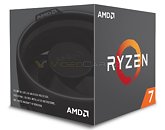Tuesday, February 21st 2017

AMD Ryzen Stock Cooling Solutions Detailed
AMD is expected to package its upcoming Ryzen desktop processors in five ways - OEM trays (for system integrators and big pre-built PC manufacturers), PIB (processor in a box) with its basic fan-heatsink cooling solution, PIB with the new Wraith Spire cooling solution; PIB with the new Wraith Max cooling solution, and WOF (without fan-heatsink consumer). You can find the various models of Ryzen processors listed in our older article.
AMD's first wave of Ryzen processors consist of 65W and 95W TDP chips. Some of the more cost-effective models, such as the quad-core Ryzen R3 and SMT-equipped quad-core Ryzen R5, and certain variants of the six-core Ryzen R5, which have their TDP rated at 65W, could include AMD's basic cooling solution. According to XFastest, this cooler will look identical to the ones AMD used to bundle with its FX-series processors, before it innovated its Wraith cooling solution (representative image below). These coolers were being bundled with 125W TDP FX-series chips, and will now be re-tuned for low noise for the 65W TDP Ryzen chips, and will feature AM4 compatibility. Given this, we expect them to do a good job.Next up, is the Wraith Spire. Included with certain non-X Ryzen 5 and Ryzen 7 processor models, this cooler has a thermal load rating of 95W. It features a round aluminium heatsink with spirally projecting fins, mated to a large (70-80 mm) fan. The cooler measures 109 mm x 103 mm x 54 mm (LxWxH), and will offer the kind of low-noise we've come to expect of AMD's Wraith cooling solutions. The PIB retail boxes will feature clear imagery to indicate the inclusion of the Wraith Spire cooler.
Lastly, there's the top-dog Wraith Max cooler. Bundled with some of the top-grade Ryzen 7 series eight-core chips, the cooler is a beefier version of the Wraith cooling solution AMD launched with the FX-series processor. It has a rated design limit of 140W thermal load, and since it will be bundled with 95W TDP Ryzen chips, one can expect good noise levels. The topmost-tier Ryzen 7 chips with "X" brand extension (eXtended frequency range feature), will ship as WOF (without fan-heatsink) packages, much like Intel sells its unlocked "K" and "X" Core processors.
Sources:
InformaticaCero, XFastest, VideoCardz
AMD's first wave of Ryzen processors consist of 65W and 95W TDP chips. Some of the more cost-effective models, such as the quad-core Ryzen R3 and SMT-equipped quad-core Ryzen R5, and certain variants of the six-core Ryzen R5, which have their TDP rated at 65W, could include AMD's basic cooling solution. According to XFastest, this cooler will look identical to the ones AMD used to bundle with its FX-series processors, before it innovated its Wraith cooling solution (representative image below). These coolers were being bundled with 125W TDP FX-series chips, and will now be re-tuned for low noise for the 65W TDP Ryzen chips, and will feature AM4 compatibility. Given this, we expect them to do a good job.Next up, is the Wraith Spire. Included with certain non-X Ryzen 5 and Ryzen 7 processor models, this cooler has a thermal load rating of 95W. It features a round aluminium heatsink with spirally projecting fins, mated to a large (70-80 mm) fan. The cooler measures 109 mm x 103 mm x 54 mm (LxWxH), and will offer the kind of low-noise we've come to expect of AMD's Wraith cooling solutions. The PIB retail boxes will feature clear imagery to indicate the inclusion of the Wraith Spire cooler.
Lastly, there's the top-dog Wraith Max cooler. Bundled with some of the top-grade Ryzen 7 series eight-core chips, the cooler is a beefier version of the Wraith cooling solution AMD launched with the FX-series processor. It has a rated design limit of 140W thermal load, and since it will be bundled with 95W TDP Ryzen chips, one can expect good noise levels. The topmost-tier Ryzen 7 chips with "X" brand extension (eXtended frequency range feature), will ship as WOF (without fan-heatsink) packages, much like Intel sells its unlocked "K" and "X" Core processors.





42 Comments on AMD Ryzen Stock Cooling Solutions Detailed
Also, bad PhotoShop is bad (sticker) :)
provide cooling solution for unlocked CPU
if it was Intel ,NONE of this has CPU cooler
I'm sad that I couldn't wait a couple months for Ryzen to hit, but I am overall happy with my X99 system.
The question; does that mean that stock cooler will provide the full 3.9GHz and perhaps sometimes "+" capability if the case has good cooling?
This is the whole point behind Intel's stock cooler bundling: it's perfectly fine for their locked processors (65W max). It's hardly noticeable with typical household activity around you (not to mention music). And if someone needs a silent setup, he can always upgrade.
Unlocked CPUs are meant for overclockers, who need a cooling solution suitable for their overclocking target.
But I am sure some still want it so its good to have the option. I just hope the low end also gets the option for some of the high end coolers.
As for the "marketing" look - while we know red is AMD's colour and it's fairly popular among PC-builders, I think they should have gone for pure black (so actually like the one in the photo) as it's much more universal. Even if the cooler performs well, quite a lot of people will get the no-cooler box and something else just not to intrude their build's theme.
As far as performance goes, we don't know anything yet, but lets hope they worked on these coolers.
I've seen a few tests of the previous Wraith and I'm not surprised AMD users developed the impression that stock coolers are useless.;)
All in all, it's not that difficult to notice that Intel's strategy is much more mature. Well... that's what we expect from the "market leader".
dunno why they stopped to ship the unlocked processor with cooler but its a lot better since you dont have extra garbage at home dude...
Regards,
THEY ARE NOT!
Let me explain why. I have been working with computers for more than 10 years now, and I mean professionally, not in my garage. In 2011, Intel launched the Sandy Bridge CPUs, I got of course a lot of models to test, including i7-2600 and 2600K. They came with a "95W" version of the stock cooler, with a copper core. With the little piece of crap, and just by raising the multiplier, you could easily go 4-4.2GHz, no voltage bumps, nothing. The temps were mid 60s while priming.
Jump to the next gen, 3570K and 3770K came out. It began... Some shitty thermal paste between the IHS and the die made it impossible to OC, even at stock with good coolers, you would go near 70C while priming. Some people were lucky, the shitty paste was a little better distributed and you could achieve either better clocks or better temps, but without delidding and applying a better TIM, it's basically impossible to achieve what the Sandy Bridge CPUs were capable of.
Other details of Sandy Bridge:
- All i5s and i7s would OC, regardless of with or without K. i7-2600@4.2, even some people with i5-2400@4GHz, etc etc etc.
- i5-2500K and i7-2600K would achieve 5GHz, at least most of them. I personally had and i7-2600K at 4,7GHz 24/7 with a shitty AIO, I believe Corsair H50. With a Noctua cooler, I believe 5GHz would be doable.
- Best IPC increase in the last 6 years of Intel.
You see, it was not the cooler that did the magic, it was Intel. But being a greedy corporation, they wouldn't care about the small customer. I don't know why this was, but maybe was to push the X platform to the customer. They began to do this when the first X79 platforms came out.
You don't agree that what Intel does is sensible? They add a sufficient cooler to locked CPUs and sell models designed for overclockers without any cooling, assuming it would be replaced anyway by most clients.
Compare this to AMD approach: they bundle a cooler to their unlocked CPUs and we know that at some point it will not be sufficient for the temperatures.
I guess we can safely assume that Wraith Max performs worse than Noctua NH-L12 and the latter is hardly a cooler recommended for overclockers (but an excellent solution for everyone else).